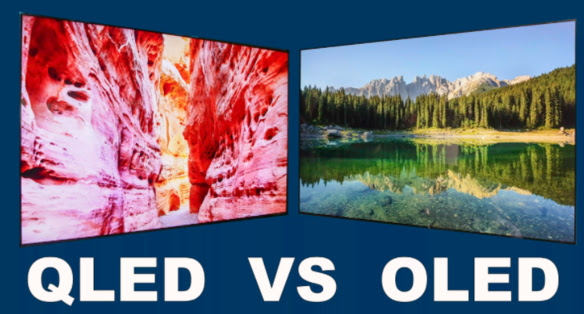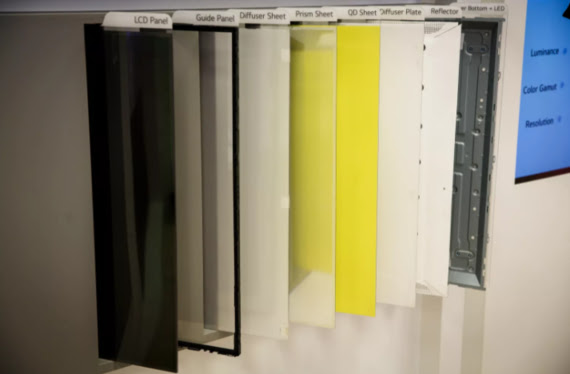- Get link
- X
- Other Apps
ad1
- Get link
- X
- Other Apps
Samsung's QLED and LG's OLED TVs sound comparative on a superficial level, however, they're totally different.
In 2021, the top-of-the-line TV scene is similarly as befuddling to new purchasers as anyone might think possible. There's a lot of new TVs to consider, a pile of specialized sounding highlights - 8K, HDR, Ultra HD 4K, 120Hz, and HDMI 2.1 - and a stable of natural brand names viewing for your dollar. Two of the greatest, Samsung and LG, utilize comparative sounding terms to portray their best TVs, yet Samsung's QLED and LG's OLED are just about as varied as day and night.
Throughout the previous few years, Samsung, the most well-known TV producer on the planet, has been marking its TVs "QLED." Its 2021 QLED arrangement is gigantic, with Neo QLED models in 4K and 8K goal, The Frame craftsmanship TV, Serif, and the Sero turning TV all bearing the omnipresent Q. In the interim, LG's 2021 OLED TVs incorporate six series, from the generally moderate A1 to the uncontrollably costly 8K Z1 to, indeed, a model that rolls up like a banner.
The OLED-versus-QLED fight goes past Samsung and LG. TCL additionally marks its best TVs "QLED" and different brands past LG likewise sell OLED TVs, in particular Sony and Vizio.
So which one is better? In our one next to the other correlation audits of picture quality, OLED beats QLED without fail. The most recent model came when we looked at the best 2021 LG OLED TV - the LG G1 series - against the best 2021 Samsung QLED TV - the QN90A series. The Samsung came nearer than any time in recent memory to OLED picture quality, however, the LG OLED actually won. Here's the reason.
(Read This:- 10-Bit vs. 8-Bit: Does Monitor Panel Bit Color Depth Matter?)
A QLED TV is only an LCD TV with quantum spots
The principal takeaway is that QLED is nearer to ordinary LCD than it is to OLED, which I (and most different specialists) think about an unmistakably unique class of TV, similar as plasma was before it.
Quantum spots are minute atoms that, when hit by light, transmit their own, diversely shaded light. In QLED TVs, the spots are contained in a film, and the light that hits them is given by a LED backdrop illumination. That light then, at that point goes through a couple of different layers inside the TV, including a fluid gem (LCD) layer, to make the image. The light from the LED source is communicated through the layers to the screen's surface, which is the reason we say it's "transmissive."
Samsung has been utilizing quantum dabs to increase its LCD TVs since 2015 and appeared the QLED TV marking in 2017. Samsung says those quantum spots have advanced over the long haul - that tone and light yield have improved, for instance. I would say notwithstanding, upgrades brought about by better quantum spots are substantially less clear than those brought about by other picture quality variables (see beneath).
Other TV producers likewise use quantum spots in LCD TVs, including Vizio and Hisense, however, don't call them QLED TVs.
An OLED TV isn't an LCD TV by any stretch of the imagination
LCD is the prevailing innovation in level board TVs and has been for quite a while. It's less expensive than OLED, particularly in bigger sizes, and various board producers around the world, including LG itself, can fabricate it.
OLED is distinctive on the grounds that it's anything but a LED backdrop illumination to create light. All things considered, light is delivered by a large number of individual OLED subpixels. The actual pixels - minuscule specks that make the picture - transmit light, which is the reason it's called an "emissive" show innovation. That distinction prompts a wide range of picture quality impacts, some of which favor LCD (and QLED), yet the vast majority of which advantage OLED.Besides the US brands referenced above, Panasonic, Philips, Grundig, and others sell OLED TVs in Europe. All utilization boards produced by LG Display, notwithstanding.
QLED versus OLED: Image quality thought about
In light of my audits, here are some broad correlations I've made between the two.
QLED TV picture quality shifts more than OLED
Samsung and TCL each have numerous QLED series and the most costly play out much better compared to the less expensive ones. That is principally in light of the fact that the greatest enhancements in the image nature of QLED sets don't have a lot to do with quantum dabs. Rather they're the aftereffect of smaller than expected LED backdrop illuminations, better full-exhibit nearby diminishing, brilliant features, and better review points, which assist them with outflanking QLED (and non-QLED) TVs that do not have those additional items.
In the meantime, each OLED TV I've assessed has very much like picture quality - all have acquired a 10/10 in picture quality in my tests. There's some variety among various OLED TVs, however, they're not close to as critical as the contrasts between different QLED TV series.
OLED has better difference and dark level
Quite possibly the main picture quality variable is dark level, and their emissive nature implies OLED TVs can turn unused pixels off totally, for in a real sense boundless difference. QLED/LCD TVs, even the best ones with the best full-exhibit neighborhood darkening, let some light through, prompting more cleaned out, grayer dark levels, and blossoming around brilliant areas.
QLED is brighter
The most splendid QLED and LCD TVs can get more brilliant than any OLED model, which is a specific benefit in brilliant rooms and with HDR content. In my tests, in any case, OLED TVs can in any case get bounty brilliant for most rooms, and their better difference actually permits them than convey a preferred in general HDR picture over any QLED/LCD TV I've tried.
OLED has better uniformity and viewing angles
With LCD-based displays, different areas of the screen can appear brighter than others all the time, and backlight structure can also be seen in some content. Even the best LCDs also fade, lose contrast and become discolored when seen from seats other than the sweet spot directly in front of the screen. OLED TVs have almost perfectly uniform screens and maintain fidelity from all but the most extreme angles.
The resolution, color, video processing, and other image quality factors are basically the same
Most QLED and OLED have the same resolution and 4K, and both can achieve 8K resolution too. Neither technology has major inherent advantages in color or video processing areas. Check out OLED vs. LCD for more details.
QLED can get bigger and smaller (and cheaper)
One big advantage, so to speak, that QLED and LCD have over OLED is the cost of mainstream sizes over 65 inches. Large televisions are the fastest-growing segment of the market and show no signs of slowing down. 77-inch OLED TVs cost $3,000 and up, significantly more than most 75-inch QLED TVs, and in larger sizes, the difference is even more drastic.
What about OLED burn-in?
Burn-in happens when a persistent part of the image onscreen -- navigation buttons on a phone or a channel logo, news ticker, or a scoreboard on a TV, for example -- remains as a ghostly background no matter what else appears onscreen. All OLED screens can burn in, and from everything I know, they're more susceptible than LCD displays, including QLED.
All things considered, however, burn-in shouldn't be a problem for most people. From all of the evidence we've seen, burn-in is typically caused by leaving a single, static image element, like a channel logo, onscreen for a very long time, repeatedly. That's an issue if you keep Fox News, ESPN, or MSNBC onscreen for multiple hours every day and don't watch enough another programming, for example. But as long as you vary what's displayed, chances are you'll never experience burn-in.
Which is better in 2021 and beyond, QLED or OLED TVs?
As I mentioned above, when I pitted the best 2021 OLED against the best 2021 QLED, OLED still won -- just like it has in previous years.
What about the future? Samsung is actually working on an OLED TV of its own (again), investing $11.1 billion in new facilities to create "QD display" tech that's basically OLED with a different name -- and quantum dots, natch. Rumors pin 2022 as the earliest customers could buy one.
Separately, and further, down the road, Samsung is researching direct-view quantum dots, which dispenses with the liquid crystal layers and uses quantum dots themselves as the light source. Emissive QLED TVs have the potential to match the absolute black levels and "infinite" contrast ratio of OLED, with better power efficiency, better color, and more. That's pretty exciting, but it'll be a few years before we see emissive QLED TVs available for sale. Hopefully, by then they'll think up a new acronym (EQLEDs?).
Archive
Archive

- ShopSahiIndia
- I am a student. My name is Mahesh Sharma. I am from Chittorgarh,India.






Comments
Post a Comment